Common Characteristics of a Clutter Clearer – Attachment Issues
Common Characteristics of a Clutter Clearer – Attachment Issues
Attachment issues refer to the way that you relate to other people.
They can be secure, which means you relate to people in a sensitive and responsive way, or insecure which means you feel insecure about, and in your relationship with other people.
Your style of attachment is learned and develops at an early age, usually within the first two years of life. What is significant about our attachment style is that what we learn as ‘normal’ in childhood is what we subconsciously recreate in our present. That means that if we experienced insecure attachment as a child, we’re likely to recreate it in our closest relationships in the present, even if it doesn’t make us happy. There are three main types of insecure attachment.
Avoidant
We will experience insecure avoidant attachment if our parents didn’t respond when we were physically or emotionally distressed as children. Crying is dismissed, and independence is encouraged. Children learn to be ‘independent little adults’. It can cause us to consider relationships and emotions as not important, supress our feelings, and wherever possible, avoid conflict and stressful situations.
Ambivalent / Anxious
We experience insecure ambivalent / anxious attachment if our parents were unpredictable and alternated between being responsive to and nurturing to our needs, and at other times intrusive and insensitive. Children become confused and insure, unable to predict the response they’ll get in any given situation. They are suspicious and distrustful as well as clingy and desperate. As adults, we become self-critical and insecure. We seek approval and reassurance from others, but this is never enough to silence the self-doubt. We worry that we will be rejected, struggle to trust, and become clingy and overly dependent on our partners and friendships.
Disorganised
We experience this when our parents are physically and/or emotionally cruel, causing us to be frightened. Our survival instincts tell us to seek safety, yet the person who is supposed to represent safety – usually the parent – is what is causing us to feel frightened. We therefore survive by disassociating ourselves from the situation. As adults we detach our feelings during times of stress and trauma. We struggle to get emotionally close to people because repressed feelings from childhood begin to resurface and trigger a re-living of old trauma. We struggle to connect with others.
How to deal with Insecure Attachment
- Understand your ‘why’. Your LIFE timeline will have clues as to whether or not you experienced any insecure attachment at any time in your life.
- Share your LIFE Timeline with a therapist or counsellor so they can help you make sense of your experiences. This new awareness and understanding will help you ‘rewire’ your brain.
- Choose to have people in your life who have a more secure attachment style than you do.
10 SIGNS OF ATTACHMENT ISSUES
- You get jealous very easily
- You constantly seek approval and reassurance from others
- You have difficulty trusting others
- You are overly controlling of the ones you love
- You are constantly judging yourself
- You don’t allow yourself to need or depend on anyone – you are fiercly independent
- You tend to put others and their needs first
- You have a hard time being alone
- You have a fear of rejection, criticism and abandonment
- You overanalyze and worry excessively
You can clear your clutter fast, or you can clear your clutter forever, but you can’t clear your clutter forever, fast.
To find out how Clare can help you clear your clutter Forever, without the need for an expensive home visit, click here now: https://www.clutterclearing.net/clares-help-centre/

